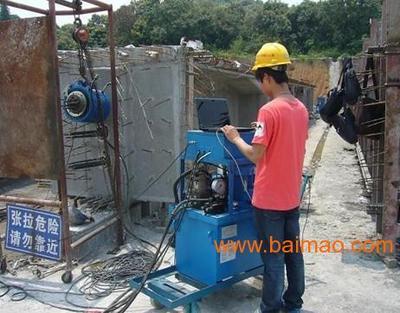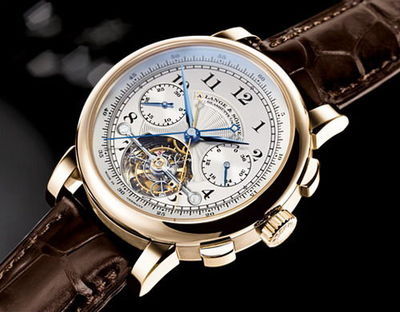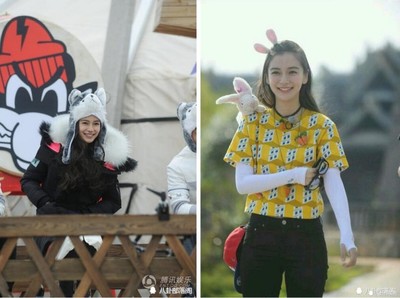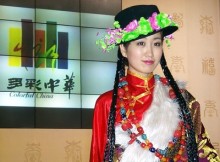英语名词的语法特点拾零
一.名词分类
英语的名词可以分为专有名词和普通名词。专有名词是某个人、地方、机构、组织、国家等专有的名称,如:Araham,John, Beijing,China,Australia, the United Nations, Sunday, etc. 普通名词包括个体名词、集体名词、抽象名词和物质名词。个体名词表示某类人、物、事中的个体,如:soldier, train, house, meeting, etc.;集体名词表示若干个个体组成的集合体,如:family, class, team,police, etc.;抽象名词表示动作、状态、品质、性质、感情等抽象概念,如:work,busyness(忙碌), sadness,beauty, love, etc.;物质名词表示无法分为个体的材料实物,如:air, water,iron, coal, tea, etc.。
抽象名词、物质名词和专有名词一般是不可数名词,因为它们都不能以数目来计算,不好分成个体,一般没有复数形式,只有单数形式,但它的前面不能用不定冠词a/an,而个体名词和部分集体名词是可数名词,它们是能以数目来计算的,因此它有复数形式。
二.名词的性
从生物学角度来分析,英语名词的性可分为四种:阳性、阴性、通性和中性。阳性、阴性和通性名词都与有生命的人和动物相关,中性名词主要指无生命的名词。
1.阳性表示男人或雄性动物的名称。例如: father, man, boy, uncle,waiter, actor, Mr., bull, etc.
2.阴性表示女人或雌性动物的名称。例如:mother, woman, girl, aunt, waitress, actess, Miss,Ms, cow, etc.
3.通性表示某一类别的名称,而不强调性别。例如:children, baby, friend, teacher, animal, fish,elephent, etc.
4.中性表示无生命的名称。例如:desk,pen,chair, room, happiness, joy, peace, nation, city,ocean, land, water, air,etc.
三.名词所有格
名词所有格相当于物主代词, 在句中作定语、宾语或主语。其构成法方法如下:
1.表示有生命的人或动物的名词在词尾加-s。例如:
My sister’s book was bought on Children’sDay.我姐姐的书是在儿童节那天买的。
I met her at the barber’s.我在理发店见到她了。
2.以s或es结尾的复数名词。只在词尾加-’。例如:
Swiss’ Team will leave on Teachers’Day.瑞士队将在教师节那天离开。
3.表示时间、距离以及城镇、国家、世界等名词,也可在词尾加-’s. 例如:
We dicussed China’s population during tenminutes’break利用十分钟的课间休息我们讨论了中国的人口问题。
4.一般情况下,都可用介词of短语来表示前者属于后者的所有关系。例如:
A daughter of Mr. Wang gave me a map of Britain.王先生的一个女儿给了我一张英国地图。
5.物主代词或名词所有格不可与a, an, this, that, these, those, some, any,several, no,each, every, such, another, which等词一起修饰一个名词,而必须用双重所有格。即:“a/this…+名词+of +名词性物主代词或名词所有格” 的形式。例如:
A friend of mine likes that car ofyours我的一个朋友喜欢你的那辆车。
This picture of your mother’s is reallybeautiful!你妈妈的这张照片真漂亮!
四.名词的数
英语的名词在句中表现出单数或复数两种形式,而复数又分为规则变化和不规则变化两种。
1.规则变化的名词有规律可循。例如:computer---computers, boy---boys, tomato---tamatoes,bus---buses, box---boxes, bush---bushes, watch---watches,country---countries,wife---wives,etc.
2.不规则变化的名词需要记住。例如:
1).变内部元音:man---men, woman---women, foot---feet, tooth---teeth, goose--- geese, mouse---mice,louse---lice, etc.
2).词尾加-s:ox---oxen, child---children, etc.
3).直接加-s:chief---chiefs, roof---roofs, belief---beliefs,safe---safes, relief---reliefs, etc.
4).直接加-s:radio---radios,studio---studios ,zoo---zoos,piano---pianos,photo---photos,zero---zeros, etc.
5).单复数形式相同:means, works,sheep, deer, fish, Chinese, bison, etc.
五.名词的作用
1.作主语
1).形式决定谓语。例如:
Alice is reading a morning newspaper.爱丽丝正在读晨报。
The students are reading in thelibrary.学生们正在阅览室看书。
2).集体名词(audience, club, committee, couple, crew, crowd,enemy, government, staff, family, class, team, group, row,police, school, etc.)做主语, 表示整体概念时谓语用单数形式;表示其中的个体成员时谓语用复数形式。例如:
His family is a large one.她的家是一个大家庭。
His family are all teachers.她的家人都是老师。
注意:集合名词cattle, people, police,etc.只作复数用, 而clothing, furniture, jewellery,machinery(机械), traffic,etc.只作单数用。例如:
Cattle provide us with milk andbeef.牛为我们提供牛奶和牛肉。
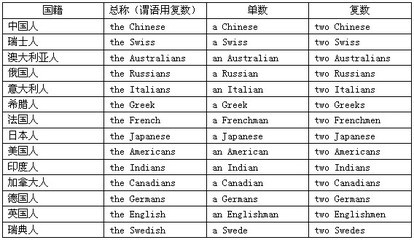
Our clothing protects us fromcold.衣服保护我们免受寒冷。
3).单复数相同(Chinese, Japanese, fish, sheep, means, works,deer, etc.)的名词表示单个时谓语用单数,表示许多时,谓语用复数。例如:
There is a sheep in the yard.院子里有只绵羊。
There are ten sheep in theyard.院子里有十只绵羊。
2.作宾语和表语
The students are practising Eglish songs in theclassroom.学生们正在教室练习英语歌曲。
He is a Net engineer.他是网络工程师。
3.作补语
We made her monitor of our class.我们选他当班长。
He is considered our best friend here.我们认为他是我们在这儿的最好朋友。
4.作定语
1).名词作定语一般用单数,但也有用复数的情况。例如:
I like folding paper planes.我喜欢叠纸飞机。
They bought new sports shoes in the departmentstore. 他们在那家百货商店买了新运动鞋。
记住:clothes store服装店,sports meeting 运动会, students reading-room学生阅览室, talks table 谈判桌, the foreign languages department外语系, goods transportation,货物运输,sales manager(营业部经理),etc.
2).数词+名词构成合成词作定语时,名词一般用单数形式。例如:
The fifteen-year-old child took a ten-mile walk and bought two-dozen papercups.那个十五岁的孩子步行了十里路,买了两打纸杯。
My first five-year plan is to plant two-thousandfruit trees .我的第一个五年计划就是种两千棵果树。
5.有些时间名词可以作状语。例如:
Every day,they go to workby bike.他们每天骑车上班。
六.不可数名词的特殊用法
1. 专有名词
1).专有名词的复数形式表示一家人或夫妻。例如:
Are the Smiths coming to our party tomorrownight?史密斯一家明晚会来参加我们的聚会吗?
2). 表示同名或同姓的若干人。例如:
There are two Marys and three Roberts in hisclass.他班上有两个玛丽和三个罗伯特。
Did the Mr. Blakes come thismorning?那几位布莱克先生今天上午来了吗?
3).姓氏及名前加不定冠词a/an表示某一位姓什么或像那样的人。例如:
A Mr. Smith is waiting for you at thegate.一位姓史密斯的先生在大门口等你。
He likes writing and hopes to be a Lu Xun.他喜欢写作,希望能成为像鲁迅那样的人。
4).有些专有名词前加a/an+形容词表示“一个不一样的……”,加定冠词表示特指。例如:
Countless revolutionaries died to found a newChina.为了建立一个新中国,无数的革命者牺牲了。
They lived a miserible life in the oldChina.在旧中国,他们过着悲惨的生活。
2.物质名词
1). 物质名词的复数形式表示不同种类。例如:
The wines of France are among the best in theworld.法国的葡萄酒是世界上最好的。
First , he wrote out a long list of all the foodswhich were forbidden.首先,他列出了一长串禁用的食品。
2). 表示量大,远远超过该词原来表示的程度或次数。这一类词常见的有:sands(沙滩,沙漠);waters(水域);rains(大阵雨、雨季);winds(大风);times(时代);woods(森林);ruins(废墟);rags(碎片、破衣服);ashes(灰烬、骨灰)。例如:
The rising waters did a lot of harm to thecrops.上涨的河水给庄稼造成了很大的损害。
These caves collapse easily in heavyrains.下大雨时这些洞穴容易倒塌。
The children are playing on thesands.孩子们在沙滩上玩。
The hurricane crossed the southeast corner ofEngland with winds of up to 160 Kph. 飓风以每小时高达160千米的阵风横扫英国东南角。
3). 某些物质名词前加不定冠词a/an或以复数形式出现表示具体的概念。例如:
Waitress, another coffee,please.服务员,再来一杯咖啡。(=another cup of coffee)
The researchers are developing a newplastic.研究人员正在研发一种新塑料。
Send two oranges and three lemonades to theroom.请将两杯橘子汁和三杯柠檬汁送到这个房间。
4). 某些物质名词的复数形式已改变了原意。例如:glasses(眼镜、玻璃杯),irons(熨斗),coppers(铜币),papers(文章,证件),airs(氛围),brains(智能),etc.
She is always wearing glasses.她总是戴着眼镜。
He wrote many papers for thenewspaper.他为这份报纸写过许多文章。
3. 抽象名词
1). congratulations, regards, respects, thanks,wishes, apologies等,其复数形式用来表示祝愿、礼貌和客气。例如:
It’s your birthday today.Congratulations!今天是你的生日,祝贺你!
You’ve given me so much help. Thanks alot.你给了我很多帮助,非常感谢。
2). smiles, pities, fears, hopes,kindnesses等,其复数形式表示强调程度或数多。例如:
He was all smiles.他满脸笑容。
Thousands of thanks!万分感谢!
Four freedoms 四大自由。
Thoughtsrushed through hishead. 他思绪万千。
3).有些抽象名词的复数形式表示具体的事物。例如:cares(烦人的事);anxieties(令人着急的事);worries(使人发愁的事);difficulties(难题);joys(使人高兴的事);failures(失败的事,失败的人);friendships(表示友谊的事例)等。
After listening to his advice, she had no moreanxieties.听了他的建议,她不再有发愁的事了。
After many failures, they finallysucceeded.经过多次失败之后,他们最后成功了。
There were four deaths and six injuries in theaccident.事故造成四死六伤。
That was a world full of wars andkillings.那是一个充满战争和杀戮的世界。
4). 某些抽象名词的复数形式表示与该个体名词不同的意义。例如:youths(男青年、小伙子),relations(亲戚),beauties(美人),necessities(必需品),demages(赔偿金),works(工厂、共事),customs(海关),goods(货物),etc.
Twenty youths attended the meetingyesterday.二十个男青年出席了昨天的会议。
All his poor relations came to spend theirholidays at his home.他所有的穷亲戚都在他家过节。
5).在词组或短语当中,一个抽象的不可数名词往往会变为一个可数名词。例如:
First,I heard a noise.首先,我听到一阵噪音。
What a delicious supper!真是一顿丰盛的晚餐!
It ‘s a great surprise!真是一件让人大为惊讶的事情!
4.用"量词+of"短语表示不可数名词的具体数量, 量词有单、复数之分。例如:
We ordered one cup of tea, two tins of Coca Colaand three glasses of water.我们要了一杯茶、两罐可口可乐和三玻璃杯水。
Well! Here is a piece of advice foryou. 那好,下面给你一条建议吧。
5.不可数名词虽然一般不能直接用不定冠词a/an或数词修饰, 但可以用定冠词the以及some, any, a lot of, much, alittle等限定词修饰。例如:
What fun it is to play with thesekids!跟这些孩子在一起玩真有意思!
How much money would you like? 你要多少钱?
七.高中阶段不可数名词归类
1.不能具体化的不可数名词有:news, information, weather, fun,furniture。
2..最常见的不可数名词有:ability, absence, addition,advice, age, anger, attention, baggage, bread, change(零钱), chichen (鸡肉), comfort, concern, courage, countryside, danger,death, delay, doubt, energy, equipment, experience, furniture,failure, fear, fish(鱼肉), food, forture, fun, health, h air, homework,ice, industry, information, ink, iron, joy, kindness, knowledge,labour, luggage, luck, marriage, mercy, money, music, nature, news,pain, paper, peace, pleasure, politics, pork, power, pride, progress, rain, regret,research, respect, rice, safety, salt, sand, sense, silence, sleep,state, steel, strength, snow, sorrow, technology, time, trade,traffic, transport, travel, trust, truth, vinegar, waste, water,wealth, weather, wind, work, worry, etc.
3.多以复数形式出现的名词有:clothes, congratulations, contributions, goods,greetings, manners (礼貌), epreparations, regards, repairs, sports,tears(泪水), thanks, wishes,etc.
 爱华网
爱华网